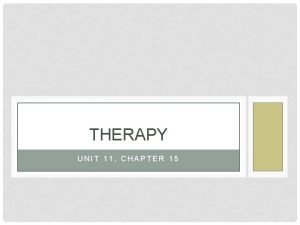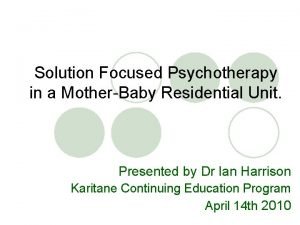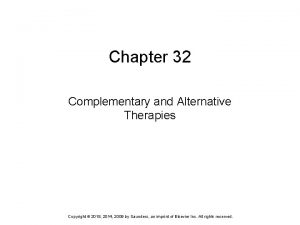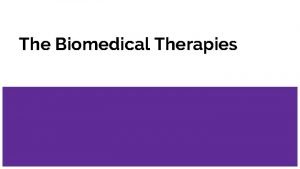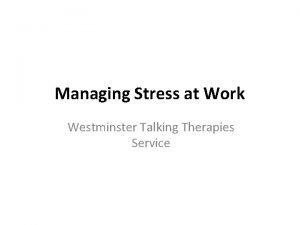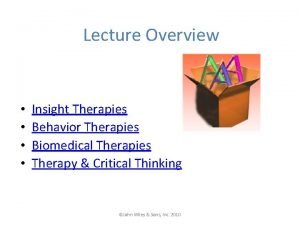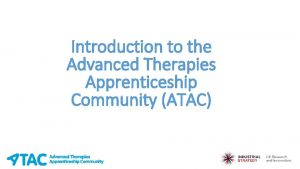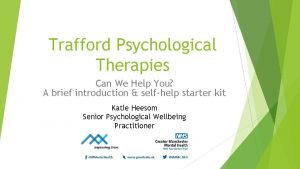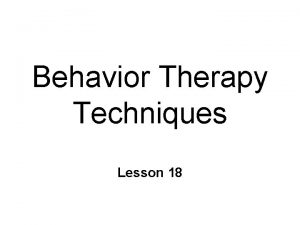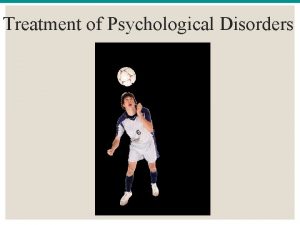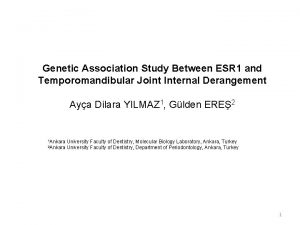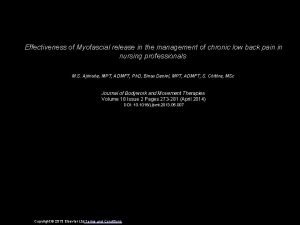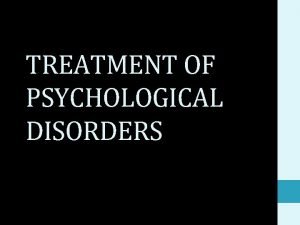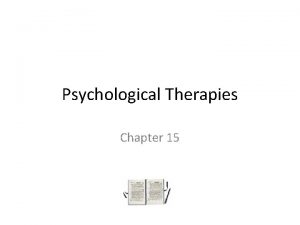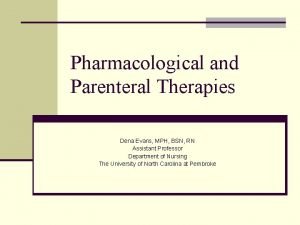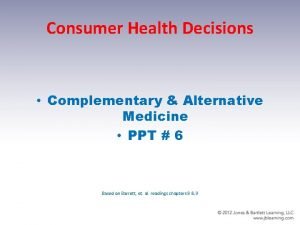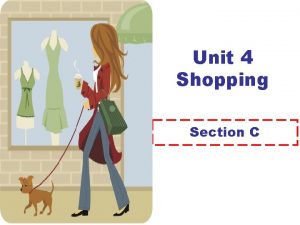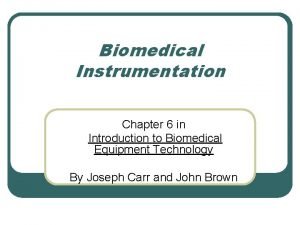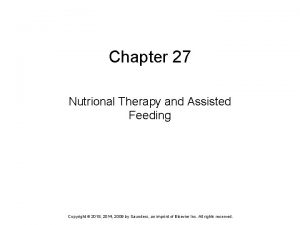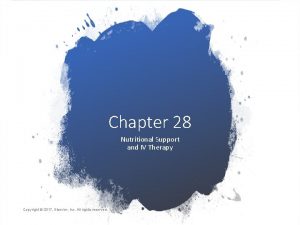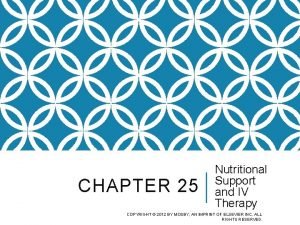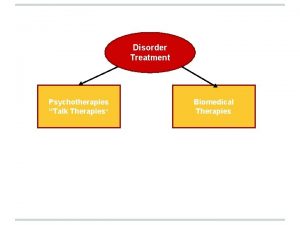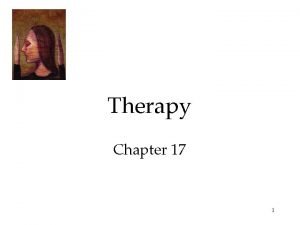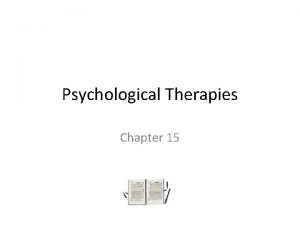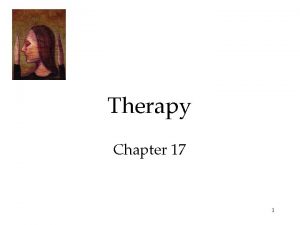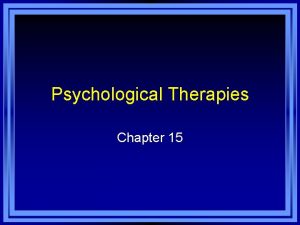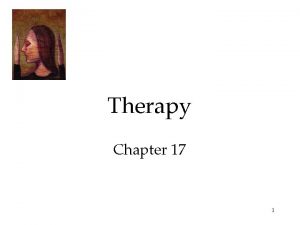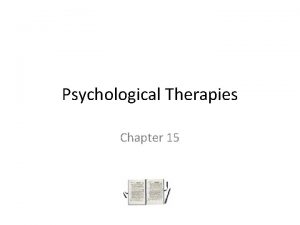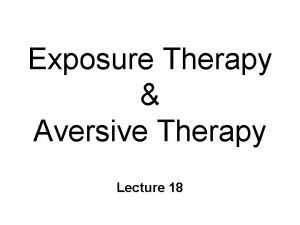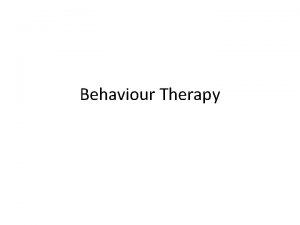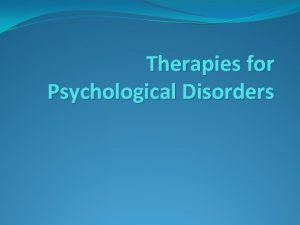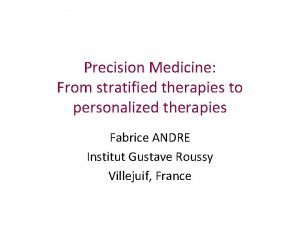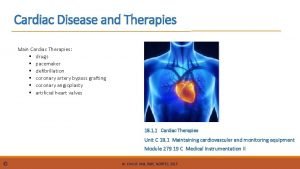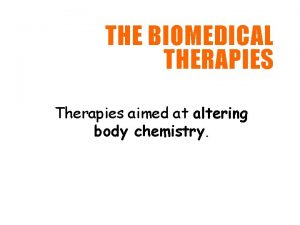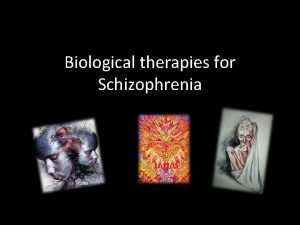THERAPY UNIT 11 CHAPTER 15 TALK THERAPIES PSYCHOANALYSISPSYCHODYNAMIC



















































- Slides: 51

THERAPY UNIT 11, CHAPTER 15

TALK THERAPIES: PSYCHOANALYSIS/PSYCHODYNAMIC THERAPIES, HUMANISTIC THERAPIES CHAPTER 15, SECTION 1 A, PAGES 495 -500

PSYCHOTHERAPY • Psychotherapy- any of a group of therapies used to treat psychological disorders and to improve psychological functioning and adjustment to life • Therapy can be for everyone, for any amount or type of stress

PSYCHOANALYSIS • Psychoanalysis- a type of talk therapy, originated by Sigmund Freud, that emphasizes bringing unconscious thoughts and conflicts into conscious awareness • Conflicts come from the psyche (id, ego, superego) and the defense mechanisms that stop them from conscious awareness • Five methods used by psychodynamic therapists: free association, dream analysis, analyzing resistance, analyzing transference, interpretation

PSYCHOANALYSIS TECHNIQUES • Free association- reporting whatever comes to mind without monitoring its contents • Lying on a couch with just the ceiling to look it is supposed to help • Dream analysis- interpretation of the underlying true meaning of dreams to reveal unconscious processes • Manifest content vs. latent content

PSYCHOANALYSIS TECHNIQUES • Analysis of resistance- examines the client’s inability or unwillingness to confront unpleasant or fearful unconscious conflicts • Analysis of transference- explores situations in which a client attaches (transfers) to therapist emotional reactions related to someone else in the client’s life • Use the safe environment for the client to relive painful relationships • Interpretation- explanation of a client’s free associations, dreams, resistance, and transference; any statement by a therapist that presents a problem in a new way

PSYCHODYNAMIC THERAPIES • Psychodynamic therapies- a group of talk therapies that focus on conscious processes and current problems • Known for being briefer, more directive, and more modern forms of psychoanalysis • • Goes to therapy less often Face-to-face, not on a couch Therapist is more likely to offer advice or support Less focus on childhood problems, more on current and conscious processes/problems

PSYCHOANALYTIC VS. PSYCHODYNAMIC

EVALUATING PSYCHOANALYSIS/ PSYCHODYNAMIC THERAPIES • Similar benefits between psychoanalysis and psychodynamic but psychodynamic is shorter and cheaper • Three major issues • Question of repressed memories and unconscious conflict- do they exist? • Limited availability- time-consuming and expensive, potentially only for highly motivated and less severe disorders • Lack of scientific credibility

HUMANISTIC THERAPIES • Humanistic therapies- a group of talk therapies that emphasize maximizing a client’s inherent capacity for self-actualization by providing a nonjudgmental, accepting atmosphere • Based on the belief that psychological disorders come from blocked growth • The client is responsible for discovering their maladaptive patterns

HUMANISTIC THERAPIES • Carl Rogers is best known humanistic therapist • Client-centered therapy- a form of talk therapy developed by Carl Rogers that provides a warm, supportive atmosphere that encourages self-actualization and improves the client’s selfconcept • Four techniques for Rogers’ therapy: empathy, unconditional positive regard, genuineness, active listening

HUMANISTIC THERAPIES: TECHNIQUES • Empathy- a sensitive understanding and sharing of another’s inner experience • Pay attention to body language and subtle cues, open-ended statements • Unconditional positive regard- Rogers’s term for love and acceptance with no “strings” (conditions) attached • Avoid evaluative statements • Genuineness- being personally authentic and sincere; the awareness of one’s true inner thoughts and feelings and the ability to share them honestly with others • Active listening- a communication technique that requires listening with total attention to what another is saying • Techniques: reflecting, paraphrasing, and clarifying what the person says and means

EVALUATION OF HUMANISTIC THERAPIES • Supporting: • Emphasizes the positives of human nature • Scientific evidence for client-centered therapy • Neutral or against • Mixed results from specific techniques • Self-actualization, self-awareness, etc. are hard to test scientifically

HUMANISTIC VS. PSYCHOANALYTIC THERAPY

TALK THERAPIES: COGNITIVE THERAPIES CHAPTER 15, SECTION 1 B, PAGES 500 -504

COGNITIVE THERAPIES • Cognitive therapies- a group of talk therapies that focus on changing faulty, distorted thoughts (cognitions) • Based on the assumption that thoughts intervene between events and reactions • Also think that looking into unexamined beliefs are important, but thinks that addressing negative self-talk is most important

COGNITIVE THERAPIES • Cognitive restructuringa therapeutic process of learning to identify, dispute, and replace irrational or maladaptive thoughts with more realistic and positive beliefs

COGNITIVE THERAPIES: ELLIS’S REBT • According to Ellis, irrational beliefs are the main cause of our problems • Rational-emotive behavior therapy (REBT)- a form of talk therapy, developed by Albert Ellis, that focuses on eliminating negative emotional reactions through logic, confrontation, and examination of irrational beliefs • In practice: • Identify and confront your belief system • Evaluate consequences • Practice effective ways of thinking and behaving

COGNITIVE THERAPIES: REBT- ABCD APPROACH • Ellis created an approach for cognitive therapy: ABCD • A- Activating event • Individual is blocked from desired goal • B- Irrational Beliefs • Individual interprets the frustration in an irrational, erroneous manner • C- Emotional Consequences • Individual experiences negative feelings, which reinforce the original irrational beliefs • D- Disputing Irrational Beliefs • Individual challenges irrational beliefs, which changes negative emotions

COGNITIVE THERAPIES: REBT- ABCD APPROACH

COGNITIVE THERAPIES: CBT • Cognitive-behavior therapy (CBT)- developed by Aaron Beck, combines cognitive therapy (changing faulty thinking) with behavior therapy (changing maladaptive behaviors) • Belief that psychological problems come from illogical thinking and destructive self-talk • Reduce self-destructive thoughts and behaviors • Notice thoughts test in reality change behavior • CBT and depression • Catch, Challenge, Change • Five maladaptive patterns: • • • Selective perception Overgeneralization Magnification and minimization Personalization All-or-nothing thinking

COGNITIVE THERAPIES: MBCT • Mindfulness-based cognitive therapy- a therapy based on developing a state of consciousness that attends to ongoing thoughts, feelings, and events in a receptive and non-judgmental way • Goal to focus on their streams of thoughts, especially at the time they are occurring • Successful for PTSD, depression, personality disorders, substance abuse

EVALUATING COGNITIVE THERAPIES • In support • Highly effective for depression, anxiety, bulimia, anger management, addiction, some schizophrenia and insomnia • Criticisms • Dysfunctional thinking may result from, not cause abnormal functioning • Ignores or denies unconscious dynamics and the client’s past • May only be successful because they employ behavior techniques

BEHAVIOR THERAPIES CHAPTER 15, SECTION 2, PAGES 505 -509

BEHAVIOR THERAPIES • Behavior therapies- a group of therapies that uses learning principles to reduce or eliminate maladaptive behaviors • Techniques are based on classical conditioning, operant conditioning, and observational learning • Based on belief that psychological disorders are caused by inappropriate conditioning and learning • Goal is to reduce maladaptive behaviors, increase adaptive ones • Aka exposure therapies

CLASSICAL CONDITIONING TECHNIQUES • Systematic desensitization- a client is first asked to create a hierarchy of ordered fears and then taught to relax while gradually confronting the feared stimulus • Used to treat phobias • The sympathetic nervous system is activated when we are anxious and we cannot be relaxed at the same time replace the fear response with relaxation

SYSTEMATIC DESENSITIZATION

CLASSICAL CONDITIONING TECHNIQUES • Aversion therapy- pairs an aversive (unpleasant) stimulus with a maladaptive behavior in order to elicit a negative reaction to the target stimulus

OPERANT CONDITIONING TECHNIQUES • Using behavior modification, therapists provide reinforcement for appropriate behavior, no punishment • May also use shaping • Token economy- a form of behavior therapy involving awarding “tokens” for desired behavior that can later be exchanged for rewards

OBSERVATIONAL LEARNING TECHNIQUES • Modeling therapy- characterized by watching and imitating models who demonstrate desirable behaviors • Can be used to treating phobias, social skills training, assertiveness training, etc. • When combined with direct and gradual practice, it is participant modeling

EVALUATING BEHAVIOR THERAPIES • Criticisms • Generalizability- real world is not consistent, so new behavior doesn’t last long • Neglect of other approaches, including unconscious, cognitive, and biological • Ethics- we shouldn’t try to control others’ behavior (refutation is that clients recognize the controls and now can change/control their own behavior) • Support • One of most widely researched and scientifically documented • Highly effective for phobias, OCD, eating disorders, autism, intellectual disabilities, delinquency

BIOMEDICAL THERAPIES CHAPTER 15, SECTION 3, PAGES 510 -516

PSYCHOPHARMACOLOGY • Biomedical therapies- group of therapies designed to alter brain functioning with biological or physical techniques, such as drugs, electroconvulsive therapy, and psychosurgery • Aka biological therapy

PSYCHOPHARMACOLOGY • Psychopharmacology- the use of drugs to relieve or control the major symptoms of psychological disorders • May be used to help a depletion or overproduction of chemicals, or to help with symptoms even if causes are not thought to be biological • Four categories: antianxiety, antipsychotic, mood stabilizer, and antidepressant

PSYCHOTHERAPEUTIC DRUG TREATMENTS • Antianxiety- used to reduce anxiety and decrease over-arousal in the brain by lowering the sympathetic activity • Can reduce alertness, coordination, reaction time; potential for intensifying other drugs • Antipsychotic- used to diminish or eliminate symptoms of psychosis by reducing agitated behaviors, hallucinations, delusions, etc. by decreasing activity at the dopamine receptors • High rate of improvement • Mood-stabilizers- used to treat the combination of manic episodes and depression characteristics of bipolar disorders by steadying mood swings • Slow to work so usually used to prevent episodes and help break the manic/depressive cycle • Antidepressants- used to treat depression, some anxiety disorders, OCD, PTSD, certain eating disorders by affecting neurochemical pathways (increasing or decreasing availability of certain chemicals, usually serotonin or norepinephrine) to elevate mood and arousal • Slow to work (weeks-months)

SSRI EXAMPLE

PSYCHOPHARMACOLOGY: EXPLORATIONS • Best understood as helping to correct an imbalance in the levels of neurotransmitters in the brain • Special K (ketamine) has been found to decrease suicidal thoughts and is fast working and effective, but shows potential for abuse, strong side effects, and has little evidence • Antidepressants can relieve depression and suicidal thoughts through neurogenesis, synaptogenesis, or stimulation of activity in brain areas • Research on psychedelic drugs shows no increased risk of mental disorders and no link between use and adverse mental health outcomes • Potentially points to improvements in mental health

ELECTROCONVULSIVE THERAPY • Electroconvulsive therapy (ECT)- based on passing electrical currents through the brain • Used almost exclusively to treat serious depression when drugs and psychotherapy have failed • Triggers brief seizures and produces changes in nervous systems (central, peripheral, autonomic), secretion of hormones and neurotransmitters, and changes in the blood-brain barrier • We don’t know much on how it works • Potential side effects include memory problems • Modern alternative- Repetitive transcranial magnetic stimulation (r. TMS)- uses repeated magnetic field pulses targeted at specific areas of the brain Above- ECT Left- r. TMS

PSYCHOSURGERY • Psychosurgery- involve alteration of the brain to bring about desirable behavioral, cognitive, or emotional changes • Generally used when clients have not responded to other forms of treatment and for serious, debilitating problems • Has been used for centuries, rarely anymore • Lobotomy- an outmoded neurosurgical procedure for mental disorders that involved cutting nerve pathways between the frontal lobes and the thalamus and hypothalamus • Did reduce emotional outbursts and aggressiveness, also caused serious brain damage

EVALUATING BIOMEDICAL THERAPIES Biomedical Therapy Support Against Psychosurgery • Clients can live normal life and not be in a hospital • More effective if combined with talk therapy • Not a cure • May become physically dependent • Side effects ECT • Valuable for severe depression • Alternative of r. TMS Psychosurgery • Deep brain stimulation • Generally irreversible (DBS) to treat Parkinson’s, • Potentially dangerous or epilepsy, major depression, fatal side effects and others) • Experimental and controversial

PSYCHOTHERAPY IN PERSPECTIVE CHAPTER 15, SECTION 4, PAGES 516 -525

THERAPY GOALS • Therapies are meant to help in five areas • • • Disturbed thoughts Disturbed emotions Disturbed behaviors Interpersonal and life situation difficulties Biomedical disturbances • A therapist’s methods depend on their training and their perspective • Eclectic approach- a treatment approach that draws from various therapies to best suit the client and the situation • Aka integrative therapy

THERAPY EFFECTIVENESS • Research shows us YES! • Non-biomedical and biomedical therapies work equally well, combined treatments are more effective than either of them alone • Short-term, long-term, informal all seem to have an effect • Certain disorders are better treated by specific approaches • Evidence-based practice in psychology (EBPP)- a newer approach to therapy that integrates the best available evidence with the clinician’s expertise, along with the client’s characteristics, culture, and preferences • Therapeutic alliance- a bond between therapist and client based on mutual trust, respect, understanding, and cooperation • An essential factor in successful therapy

THERAPY FORMATS (OTHER THAN FACETO-FACE) • Group therapies- a number of people with similar concerns meet together to work toward therapeutic goals guided by a professional • Self-help group- a leaderless or non-professionally guided group in which members assist each other with a specific problem • Benefits- less expensive, broader base of social support, learn from others’ experiences, share insights and coping strategies, role-play, useful if combined with individual • Drawbacks- less individual attention

• THERAPY FORMATS (OTHER THAN FACE-TO-FACE) • Marriage and family involve many interdependent people a problem with one means problem for all therapy can help • Family therapy- has a primary aim to change maladaptive family interaction patterns • Usually seen all together, maybe in smaller groups • May start with focus on individual, but all can benefit • Can help improve communication, treat adolescent substance abuse and eating disorders

THERAPY FORMATS (OTHER THAN FACETO-FACE) • Electronic therapy is now offered over the internet, email, or virtual reality • Telehealth uses interactive web-based conference systems • Easy and cheap way to allow clients to be exposed to therapy • Concerns involve unqualified or incompetent therapists abusing this process

CAREERS IN MENTAL HEALTH • • Clinical psychologists Counseling psychologists Pastoral counselors Psychiatrists Psychiatric nurses Psychiatric social workers School psychologists

INSTITUTIONALIZATION • Involuntary commitment • Criteria varies but usually includes • Poses a danger to themselves or others • In serious need of treatment • No reasonable, less restrictive alternative • Emergency 24 -72 hour situations to receive lab tests and psychological help • Deinstitutionalization • Overuse of involuntary commitment and expenses involved have led to this policy • Humane and positive for many • Others are discharged without continued needed help without a good place to go • Solution- expanding and improving community care, psychiatric units in hospitals, walk-in clinics

GENDER AND CULTURAL DIVERSITY • Cultural issues • Similar key features • • • Naming the problem Demonstrating the right qualities Establishing credibility Placing the problem in a familiar framework Applying techniques to bring relief Meeting at a special time and place • Differences • Western- client focused and emphasis on control of his/her life • Collectivistic cultures- interpersonal sensitivity, interdependence, acceptance of life realities • Differs on how abnormal is defined

GENDER AND CULTURAL DIVERSITY • Gender and therapy • Rates of diagnosis and treatment of mental disorders- women are diagnosed more often • Stress of poverty- women are more likely to be poor contributes to stress more disorders • Violence against women- more likely to happen to women, which can lead to disorders • Stresses of multiple roles and gender-role conflict

KEYS TO GOOD MENTAL HEALTH • Recognize and control your thoughts • Three C’s of Beck’s cognitive therapy • Positive view of the future, optimistic attributional style of thinking • Meditation (MBSR) • Acknowledge and express your feelings • Positive emotions, like gratitude • Well-being therapy (WBT)- a newer form of psychotherapy aimed at enhancing psychological well-being by focusing on personal growth and the positive aspects of life • Empathy is important • Love for yourself-care, self-compassion • Recognize and change your behaviors • • Exercise, eat well, sleep Make someone else feel good Enjoy and maintain social connections Try writing
 Difference between psychoanalysis and psychodynamic
Difference between psychoanalysis and psychodynamic Talk read talk write
Talk read talk write Amateurs talk strategy professionals talk logistics
Amateurs talk strategy professionals talk logistics Problem talk vs solution talk
Problem talk vs solution talk Chapter 32 complementary and alternative therapies
Chapter 32 complementary and alternative therapies Both psychoanalysis and humanistic therapy stress
Both psychoanalysis and humanistic therapy stress Bioness integrated therapy system occupational therapy
Bioness integrated therapy system occupational therapy Humanistic therapies aim to boost
Humanistic therapies aim to boost Module 73 the biomedical therapies
Module 73 the biomedical therapies What is biomedical therapy
What is biomedical therapy Stiriti ayur therapies
Stiriti ayur therapies Westminster talking therapies
Westminster talking therapies Biomedical therapy techniques
Biomedical therapy techniques Advanced therapies apprenticeship community
Advanced therapies apprenticeship community Trafford psychological therapies
Trafford psychological therapies Flooding therapy
Flooding therapy Trafford psychological therapies
Trafford psychological therapies Most common form of biomedical therapy
Most common form of biomedical therapy Astellas gene therapies
Astellas gene therapies Pvu
Pvu Bodywork and movement therapies
Bodywork and movement therapies Insight therapies involve verbal interactions
Insight therapies involve verbal interactions Trafford psychological therapies
Trafford psychological therapies Advantages of group therapy
Advantages of group therapy Pharmacological and parenteral therapies
Pharmacological and parenteral therapies Trafford psychological therapies
Trafford psychological therapies Alternative and complementary therapies ppt
Alternative and complementary therapies ppt Unit 10, unit 10 review tests, unit 10 general test
Unit 10, unit 10 review tests, unit 10 general test Unit 1 small talk
Unit 1 small talk In this unit you learned to talk about home maintenance
In this unit you learned to talk about home maintenance Unit 4 shopping therapy
Unit 4 shopping therapy Great gastby chapter 4 summary
Great gastby chapter 4 summary Art talk chapter 6 review answers
Art talk chapter 6 review answers An organized approach for studying a work of art
An organized approach for studying a work of art Ngt the talk chapter 6
Ngt the talk chapter 6 Chapter 27 nutritional therapy and assisted feeding
Chapter 27 nutritional therapy and assisted feeding Chapter 19 methods of therapy
Chapter 19 methods of therapy Chapter 28 nutritional support and iv therapy
Chapter 28 nutritional support and iv therapy Chapter 28 nutritional support and iv therapy
Chapter 28 nutritional support and iv therapy Chapter 28 nutritional support and iv therapy
Chapter 28 nutritional support and iv therapy Surplus keuangan adalah
Surplus keuangan adalah Right triangle trigonometry examples
Right triangle trigonometry examples Si vs english units
Si vs english units Algebra 2 unit 1 practice test
Algebra 2 unit 1 practice test Contoh unit cost rekam medis
Contoh unit cost rekam medis Unit process and unit operation
Unit process and unit operation Difference between unit process and unit operation
Difference between unit process and unit operation Setiap unit akuntansi dianggap sebagai unit yang mandiri
Setiap unit akuntansi dianggap sebagai unit yang mandiri Supertato talk for writing
Supertato talk for writing Toolbox talk eye protection
Toolbox talk eye protection What is your favourite holiday destination and why
What is your favourite holiday destination and why My favourite holiday destination
My favourite holiday destination
